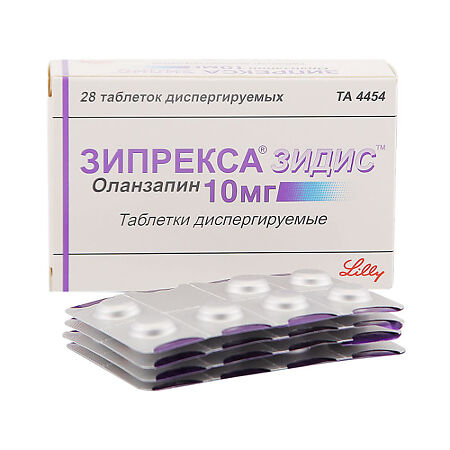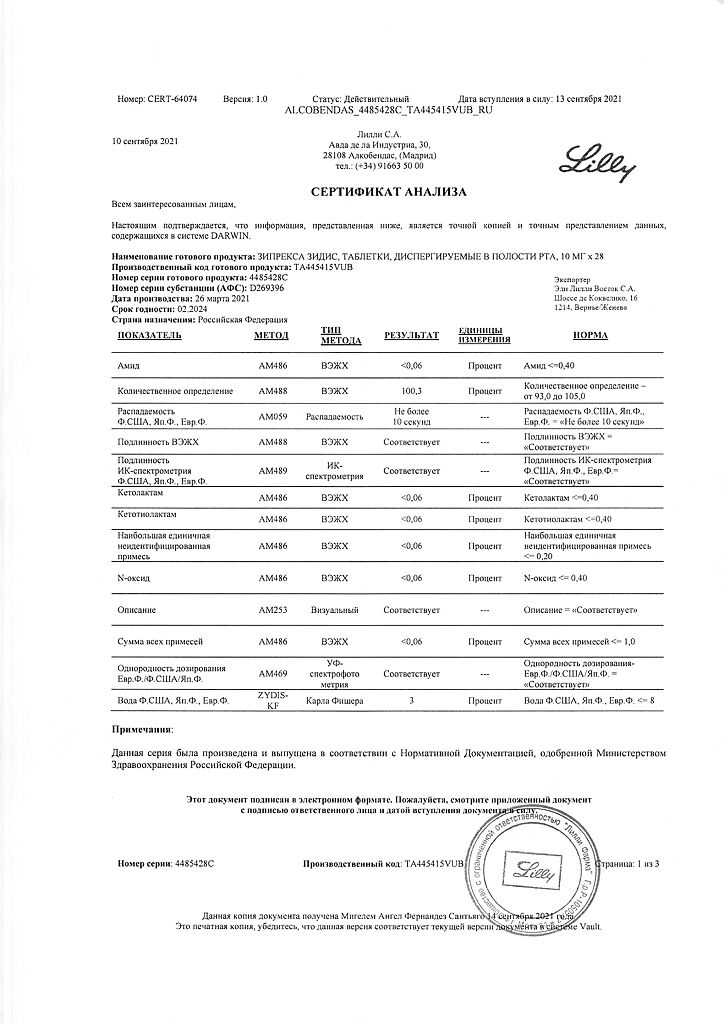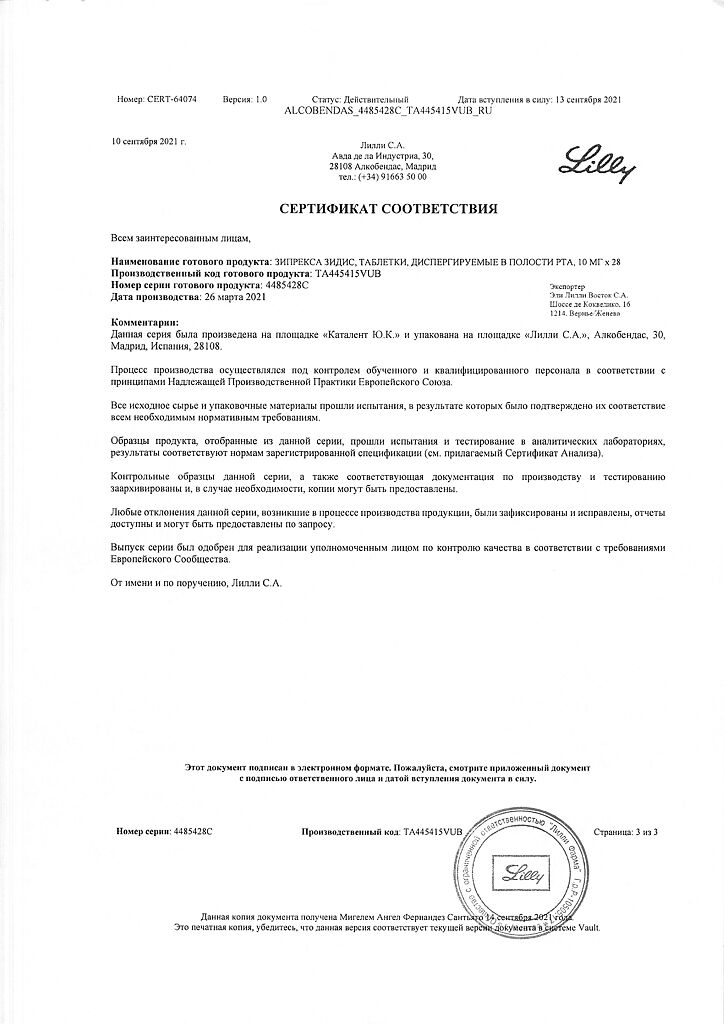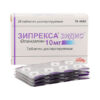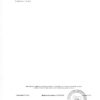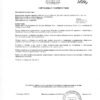No products in the cart.
Zyprexa Zydis, 10 mg 28 pcs
€1.00
Out of stock
(E-mail when Stock is available)
Description
Zyprexa Zadis has antipsychotic effects.
Pharmacodynamics
Preclinical studies have established the affinity of olanzapine for the serotonin 5-NT2A/2C, 5-NT3, 5-NT6; dopamine D1, D2, D3, D4, D5; muscarinic M1-5; α1-adrenoreceptors and histamine H1-receptors. Experimental animal studies revealed the presence of olanzapine antagonism to serotonin 5-NT-, dopamine and cholinoreceptors. Under in vitro and in vivo conditions olanzapine has a more pronounced affinity and activity towards serotonin 5-NT2-receptors compared to dopamine D2-receptors.
According to electrophysiological studies, olanzapine selectively reduces excitability of mesolimbic (A10) dopaminergic neurons and at the same time has a small effect on striatal (A9) nerve pathways involved in the regulation of motor functions. Olanzapine reduces the conditioned protective reflex (the test that characterizes antipsychotic activity) at doses lower than those that cause catalepsy (a disorder reflecting an adverse effect on motor function). Olanzapine enhances the anti-anxiety effect of the anxiolytic test.
Olanzapine provides statistically reliable reduction of both productive (including delirium, hallucinations) and negative disorders.
Pharmacokinetics
Dispersible olanzapine tablets and coated olanzapine tablets are bioequivalent and have similar rates and rates of absorption. Dispersible olanzapine tablets are used in the same quantity and frequency as coated olanzapine tablets. Dispersible olanzapine tablets can be used in place of coated olanzapine tablets.
Introduction. After oral administration, olanzapine is well absorbed from the gastrointestinal tract. Cmax in plasma is reached after 5-8 hours. Absorption of olanzapine is not dependent on food intake. Studies with different doses ranging from 1 to 20 mg have shown that plasma concentrations of olanzapine vary linearly and in proportion to the dose.
Distribution. At plasma concentrations of 7 to 1000 ng/ml, binding to plasma proteins is about 93%. Olanzapine mainly binds to albumin and acidic α1-glycoprotein.
Metabolism. Olanzapine is metabolized in the liver by conjugation and oxidation processes. The major circulating metabolite is 10-N-glucuronide, which theoretically does not penetrate the BBB. CYP1A2 and CYP2D6 isoenzymes are involved in the formation of N-desmethyl- and 2-hydroxymethyl-metabolites of olanzapine. Both metabolites have significantly less pronounced in vivo pharmacological activity than olanzapine in experimental animal studies. The main pharmacological activity of the drug is due to the unchanged substance, olanzapine, which has the ability to penetrate through the HEB.
The activity of CYP2D6 isoenzyme does not affect the metabolism of olanzapine.
Elimation. In healthy volunteers after oral administration, the mean T1/2 is 33 h (21-54 h for 5-95%) and the mean plasma clearance of olanzapine is 26 L/h (12-47 L/h for 5-95%). About 57% of radioisotope-labeled olanzapine is excreted with the urine and 30% with the feces, mostly as inactive metabolites.
Pharmacokinetics in special clinical cases
The variability of olanzapine pharmacokinetic parameters according to smoking, sex and age are shown in the table.
Patient characteristicsT1/2, hPlasma clearance, l/hNonsmokers38.618.6Smokers30.427.7Women36.718.9Men32.327.3Elderly (65 years and older)51.817.5Lower than 65 years33.818.2
Patient characteristics However, the degree of change in T1/2 and clearance under the influence of each of the factors listed in the table is significantly less than the degree of variation in these parameters among individuals.
There were no significant differences between the mean T1/2 and plasma clearance values of olanzapine in subjects with severe renal impairment compared to subjects with normal renal function.
In smokers with mild hepatic impairment, clearance of olanzapine is lower than in nonsmokers without hepatic impairment.
There were no race-related differences in olanzapine pharmacokinetics in a study involving persons of European, Japanese, and Chinese descent.
Indications
Indications
Active ingredient
Active ingredient
Composition
Composition
1 tablet contains:
the active ingredient:
olanzapine 10 mg,
auxiliary substances:
gelatin,
mannitol,
aspartame,
sodium methyl parahydroxybenzoate,
sodium propyl parahydroxybenzoate.
How to take, the dosage
How to take, the dosage
Ingestion, regardless of meals. Because of its brittleness, the tablet should be taken immediately after removal from the blister. Dispersible olanzapine tablets dissolve quickly in saliva and are easily swallowed. Alternatively, the tablet may be dissolved in a glass of water or other liquid (orange juice, apple juice, milk or coffee) immediately before taking.
The daily dose has to be adjusted individually, depending on the clinical condition of the patient.
For the treatment of schizophrenia and similar psychotic disorders, the recommended starting dose of olanzapine is 10 mg once daily. Therapeutic doses of olanzapine range from 5 to 20 mg/day. Increasing the dose beyond the standard daily dose of 10 mg is recommended only after an appropriate clinical evaluation of the patient.
For the treatment of acute mania in bipolar disorder, the recommended starting dose of olanzapine is 15 mg once daily as monotherapy or 10 mg once daily in combination with lithium or valproate. Therapeutic doses of olanzapine range from 5 to 20 mg per day. Increasing the dose beyond the standard daily dose of 15 mg is recommended only after an appropriate clinical examination of the patient. The dose should be increased gradually, at intervals of at least 24 hours.
Supportive therapy in bipolar disorder: patients who have taken olanzapine for treatment of acute mania should continue supportive therapy at the same dose. In patients in remission, the recommended initial dose of olanzapine is 10 mg once daily. Thereafter, the daily dose should be adjusted individually depending on the patient’s clinical condition, within a range of 5 to 20 mg/day.
Olanzapine in combination with fluoxetine should be administered once daily, regardless of meals. The starting dose is usually 5 mg of olanzapine and 20 mg of fluoxetine. If necessary, doses of both olanzapine and fluoxetine may be changed.
In elderly patients or patients with other clinical risk factors, including severe renal impairment or moderate hepatic impairment, it is recommended that the starting dose of olanzapine be reduced to 5 mg/day.
For patients with a combination of factors in which olanzapine metabolism may be delayed (female patients, elderly, nonsmokers), reduction of the starting dose of olanzapine may also be recommended.
Research data on olanzapine therapy in children and adolescents under 18 years of age are limited.
Interaction
Interaction
Metabolism of olanzapine may be altered by inhibitors or inducers of cytochrome P450 system isoenzymes with specific activity against CYP1A2. Clearance of olanzapine is increased in smoking patients and in patients taking carbamazepine (due to increased CYP1A2 activity). Known potential CYP1A2 inhibitors may decrease clearance of olanzapine. Olanzapine is not a potential inhibitor of CYP1A2 activity, therefore pharmacokinetics of drugs mainly metabolized with CYP1A2 (such as theophylline) are not changed when taking olanzapine.
In clinical studies it has been shown that a single dose of olanzapine against therapy with the following drugs was not accompanied by inhibition of metabolism of these drugs: imipramine or its metabolite desipramine (CYP2D6, CYP3A, CYP1A2), warfarin (CYP2C19), theophylline (CYP1A2) or diazepam (CYP3A4, CYP2C19). There is also no evidence of drug interaction when olanzapine is used in combination with lithium or biperiden.
There have been no changes in the pharmacokinetics of ethanol against a background of stable concentrations of olanzapine. However, administration of ethanol together with olanzapine may be accompanied by enhancement of pharmacological effects of olanzapine, such as sedation.
Single doses of antacids containing aluminum or magnesium or cimetidine did not impair bioavailability of olanzapine when taken orally. Co-administration of activated charcoal reduced the bioavailability of olanzapine when taken orally by up to 50-60%. Fluoxetine (60 mg once or 60 mg daily for 8 days) causes an increase in Cmax of olanzapine by an average of 16% and a decrease in clearance of olanzapine by an average of 16%. The magnitude of this effect is significantly less than the severity of individual differences in these indices, so it is generally not recommended to change the dose of olanzapine when it is prescribed in combination with fluoxetine.
Fluvoxamine, a CYP1A2 inhibitor, reduces the clearance of olanzapine. This results in a mean increase in Cmax of olanzapine with fluvoxamine administration of 54% in non-smoking women and 77% in smoking men, and a mean increase in AUC of olanzapine of 52% and 108%, respectively. Low-dose olanzapine should be administered to patients who are co-treated with fluvoxamine.
In in vitro studies using human liver microsomes, olanzapine has been shown to slightly inhibit the formation of valproate glucuronide (the main pathway of valproate metabolism). Valproate also insignificantly affects the in vitro metabolism of olanzapine. Therefore, a clinically significant pharmacokinetic interaction between olanzapine and valproate is unlikely.
In vitro olanzapine shows antagonism to dopamine and, like other antipsychotics (neuroleptics), can theoretically inhibit the effects of levodopa and dopamine agonists.
Is absorption of olanzapine is not dependent on food intake.
In in vitro studies using human liver microsomes, olanzapine has also shown very little potential to inhibit the activity of the following cytochrome P450 isoenzymes: CYP1A2, CYP2C9, CYP2C19, CYP2D6 and CYP3A.
Special Instructions
Special Instructions
In comparative studies, treatment with olanzapine was significantly less likely to result in dyskinesia requiring medication correction than the use of typical and other atypical antipsychotics. However, the risk of tardive dyskinesia during long-term therapy with neuroleptics should be considered. If signs of tardive dyskinesia develop, adjustment of the neuroleptic dose is recommended. It should be considered that when transferring to olanzapine, symptoms of tardive dyskinesia may develop due to a one-time withdrawal of prior therapy.
The efficacy of olanzapine in elderly patients with psychosis associated with dementia has not been established. In this category of patients in placebo-controlled clinical trials, the mortality rate in the olanzapine group was higher than in the placebo group (3.5% vs. 1.5%, respectively). Risk factors that may predispose this group of patients to higher mortality with olanzapine treatment include age >80 years, sedation, concomitant use with benzodiazepines, or the presence of pulmonary pathology (e.g., pneumonia with or without aspiration).
There are insufficient data to establish differences in the incidence of cerebrovascular events and/or mortality (compared to placebo), and in risk factors in this patient group when olanzapine is taken orally and when administered by injection/m.
In isolated cases, olanzapine administration, usually early in therapy, has been accompanied by transient, asymptomatic increases in serum liver transaminase (AST and ALT) levels. Rare cases of hepatitis have been noted. Special caution is necessary in case of increase of AST and/or ALT levels in serum in patients with hepatic insufficiency, with limited liver functional reserve or in patients treated with potentially hepatotoxic medicines. If AST and/or ALT levels increase during treatment with olanzapine, close monitoring of the patient and, if necessary, dose reduction is required.
There is a higher prevalence of diabetes mellitus in patients with schizophrenia. As with some other antipsychotics, very rare cases of hyperglycemia, diabetes mellitus, exacerbation of pre-existing diabetes, ketoacidosis, and diabetic coma have been reported. A causal relationship between antipsychotics and these conditions has not been established. Close clinical monitoring of patients with diabetes mellitus and patients with risk factors for diabetes mellitus is recommended.
Olanzapine should be used with caution in patients with a history of epileptic seizures or who are exposed to factors that lower the seizure threshold. Seizures have rarely been observed in such patients during treatment with olanzapine.
Cerebrovascular adverse reactions (e.g., stroke, transient ischemic attack), including death, have been reported in studies of olanzapine in elderly patients with psychosis associated with dementia. In placebo-controlled trials, a higher incidence of cerebrovascular adverse events was observed in patients in the olanzapine group compared to the placebo group (1.3% vs. 0.4%, respectively).
All patients with cerebrovascular disorders had prior risk factors for cerebrovascular adverse reactions (e.g., previous history of a cerebrovascular adverse reaction or transient ischemic attack, hypertension, smoking), and comorbidities and/or medication use that were temporally associated with cerebrovascular adverse reactions. Olanzapine is not indicated for the treatment of patients with psychosis associated with dementia.
As with other neuroleptics, caution should be exercised when treating the following groups of patients with olanzapine:
– with decreased peripheral blood leukocyte and/or neutrophil counts due to various causes;
– with a history of bone marrow suppression/toxic impairment due to drug exposure;
– with suppression of bone marrow function due to a history of comorbidities, radiotherapy or chemotherapy;
– with hypereosinophilia or myeloproliferative disease.
In clinical studies, use of olanzapine in patients with a history of clozapine-dependent neutropenia or agranulocytosis was not associated with recurrence of these disorders.
In clinical trials, therapy with olanzapine has rarely been associated with anticholinergic side effects. However, clinical experience with olanzapine in patients with comorbidities is limited, so caution is advised when prescribing olanzapine to patients with clinically significant prostatic hypertrophy, paralytic bowel obstruction, closed-angle glaucoma and similar conditions.
In view of the main effect of olanzapine on the CNS, caution should be exercised when using olanzapine in combination with other centrally acting drugs as well as alcohol.
Impact on driving and operating machinery
Patients taking olanzapine should exercise caution when operating motor vehicles, including motor vehicles, because olanzapine may cause drowsiness.
Contraindications
Contraindications
Side effects
Side effects
Very common (â¥10%) – somnolence, weight gain; 34% – increase in plasma prolactin concentration, which was weakly expressed and transient (the mean value of maximum prolactin concentrations did not reach the upper limit of normal (ULN) and was not statistically significantly different from placebo). Clinical manifestations of hyperprolactinemia associated with olanzapine administration (i.e., gynecomastia, galactorrhea, and breast enlargement) were rare. In most patients, normalization of prolactin levels was observed without withdrawal of olanzapine.
Frequent (â¥1% but less than 10%) dizziness, asthenia, akathisia, increased appetite, peripheral edema, orthostatic hypotension, dry mouth, and constipation. In clinical trials (n=107), 1.9% of cases had triglyceride levels of 2 or more times the IGN (no cases of more than 3 times the IGN were observed).
Rarely: transient, asymptomatic increase of hepatic transaminases (AST and ALT) in serum.
In isolated cases: elevation of plasma glucose levels to â¥200 mg/dL (suspected diabetes mellitus) and from â¥160 mg/dL but to less than 200 mg/dL (suspected hyperglycemia) in patients with baseline glucose levels â¤140 mg/dL.
In isolated cases: asymptomatic eosinophilia.
Unwanted effects in special patient groups
In patients with psychosis associated with dementia, gait disturbances and falls were very common (â¥10%).
In elderly patients with psychosis associated with dementia, urinary incontinence and pneumonia were common (â¥1%, but less than 10%).
In patients with psychosis induced by taking the drug (dopamine agonist) for Parkinson’s disease, an increase in Parkinsonian symptoms and hallucinations were reported very frequently (â¥10%) and with higher frequency than in the placebo group.
In patients with bipolar mania receiving olanzapine in combination with lithium or valproate, weight gain, dry mouth, increased appetite, and tremor were observed very frequently (â¥10% but less than 10%); speech disorders were observed frequently (â¥1% but less than 10%).
The main side effects and their frequency reported during clinical trials and/or in the post-registration period are outlined below.
Body side effects in general: â¥10% – weight gain1; â¥1% but 2; â¥0.1% but 2; less than 0.01% – allergic reaction3, 4; withdrawal reaction3, 5.
Cardiovascular aspects: â¥0.1% but less than 1%, bradycardia2; â¥1% but less than 10%, orthostatic hypotension1; less than 0.01%, venous thromboembolism3.
Digestive system: â¥1% but less than 10% – constipation2; dry mouth2; increased appetite2; less than 0.01% – hepatitis3; pancreatitis3.
Metabolic aspects: less than 0.01% – diabetic coma3; diabetic ketoacidosis3, 4; hyperglycemia3; hypertriglyceridemia3, 7; â¥1%, but less than 10% – peripheral edema1.
Muscular system: less than 0.01% – rhabdomyolysis3.
CNS side: â¥1%, but less than 10% – akathisia2; dizziness2; â¥0.01%, but less than 0.1% – seizures3; â¥10% – somnolence2.
Dermatological reactions: â¥0.01%, but less than 0.1% – rash3.
Anxiety to the sexual system: less than 0.01% – priapism3.
Laboratory findings: â¥1% but less than 10% – increase in ALT1 and AST1 levels; single cases of increased blood glucose levels from â¥160 mg/dL to less than 200 mg/dL (suspected hyperglycemia)1; single cases of increased blood glucose levels to â¥200 mg/dL (suspected diabetes)1; single cases of increased triglyceride levels of â¥2 times VGH1; â¥10% – increased prolactin levels1.
Hematopoietic system: in â¥1% but less than 10% of cases, eosinophilia1; in â¥0.01% but less than 0.1% of cases, leukopenia3; less than 0.01%, thrombocytopenia3.
1 assessment of indicators from the clinical trials database
2 side effects reported in the clinical trials database
3 side effects reported spontaneously in post-marketing studies
4 e.g: anaphylactic reaction, angioedema, pruritus or urticaria
5themi.e., sweating, nausea, or vomiting
6 in the COSTART classification is referred to as diabetic acidosis
7 in the COSTART classification is referred to as hyperlipidemia.
Overdose
Overdose
Symptoms:Very common (â¥10%) – tachycardia, agitation/aggressiveness, articulation disorder, various extrapyramidal disorders and impaired consciousness of varying severity (from sedation to coma). Other clinically significant symptoms – seizures, malignant neuroleptic syndrome, respiratory depression, aspiration, arterial hypertension or hypotension, cardiac arrhythmias (
The treatment: standard procedures for overdose are indicated (gastric lavage, administration of activated charcoal). There is no specific antidote for olanzapine. Induction of vomiting is not recommended. Co-administration of activated charcoal has been shown to reduce the bioavailability of olanzapine when taken orally to 50-60%.
Symptomatic therapy in accordance with the clinical condition and control of vital organ functions, including treatment of arterial hypotension, circulatory disorders and maintenance of respiratory function are indicated. Epinephrine, dopamine, and other sympathomimetics that are β-adrenoreceptor agonists should not be used because stimulation of these receptors may exacerbate arterial hypotension.
Pregnancy use
Pregnancy use
There is insufficient clinical experience with the use of olanzapine in pregnancy, so the drug may only be prescribed when the expected benefit of therapy to the mother significantly exceeds the potential risk to the fetus.
Patients should be advised that if they become pregnant or plan to become pregnant while being treated with olanzapine, they should inform their physician.
The study found that olanzapine is excreted with breast milk. The average dose (mg/kg) received by the infant at maternal CSS was 1.8% of the maternal dose (mg/kg). If it is necessary to use the drug during lactation, it is recommended to stop breastfeeding.
The use in patients with hepatic impairment. For patients with moderate hepatic impairment and severe renal impairment, it is recommended to reduce the starting dose of olanzapine to 5 mg/day.
Similarities
Similarities
Additional information
| Weight | 0.017 kg |
|---|---|
| Shelf life | 2 years |
| Conditions of storage | In a dry, light-protected place at 15-30 °C |
| Manufacturer | Lilly del Caribe Inc., Puerto Rico |
| Medication form | Oral dispersible tablets |
| Brand | Lilly del Caribe Inc. |
Related products
Buy Zyprexa Zydis, 10 mg 28 pcs with delivery to USA, UK, Europe and over 120 other countries.

